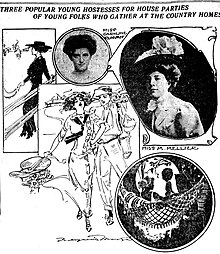House party
This article needs to be updated. The reason given is: Needs historical context and examples. (June 2021) |
This article does not cite any sources. (April 2014) |



A house party is a type of party where people gather at the residence of the party's host.
Organization[]
A house party might be organized several months, or down to just a few hours, in advance. News of a party is often spread by word of mouth, the sending of formal invitations, or on social networking websites like Facebook. In the case of the latter, the host must be particularly careful of how public the information regarding the party is made. There have been cases where hundreds of people have turned up to a party they found out about on the internet without knowing the host personally, causing massive damage to the house or the items within it. In the United Kingdom, such an occurrence may be referred to as a 'Skins' party, named after a well-known TV show set in the English city of Bristol focusing on the lives of teenagers who often participate in and host such parties.
A person who attends a house party, but has not been invited, is typically referred to as a "gatecrasher". Such an activity is usually perceived negatively, although more liberal hosts may permit gatecrashers, depending on their behavior.
In some instances house parties do not attract large crowds, and with ten or fewer people are often referred to as a 'gathering'.[citation needed]
House parties in history[]
An early example of a house party can be seen in the play Mostellaria (The Haunted House) by the Roman playwright Plautus. In the play, a young man called Philolaches is holds a house party with many friends while his father Theopropides is away on business.
House parties have become a prominent feature in popular movies, particularly movies aimed at teenagers. While many have probably been present before the movie, Animal House is one of the first to properly provide a scene of a house party.
In the former Yugoslavia[]
In the former Yugoslavia, a sijelo (In Ijekavian), silo (In Ikavian) or selo (In Ekavian) is an evening social gathering at a house. The use of the word sijelo is particularly widespread in Bosnia and Herzegovina.
See also[]
| Look up house party in Wiktionary, the free dictionary. |
- Cocktail party
- House Party, Inc.
- House Party (radio and TV show)
- Political houseparty
- Šokačko sijelo, minority festival
References[]
Bibliography[]
For Sijelo:
- Milenko S. Filipović (1982). Among the people, native Yugoslav ethnography: selected writing of Milenko S. Filipović. Michigan Slavic Publications, Dept. of Slavic Languages and Literatures. p. 97.
- Norman M. Naimark; Holly Case (2003). Yugoslavia and Its Historians: Understanding the Balkan Wars of the 1990s. Stanford University Press. ISBN 978-0-8047-4594-9.
- Sexuality and society
- Parties
- Youth culture
